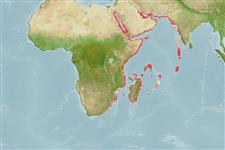Teleostei (teleosts) >
Ovalentaria/misc (Various families in series Ovalentaria) >
Plesiopidae (Roundheads) > Plesiopinae
Etymology: Plesiops: Greek, plesios = near + Greek, ops = appearance (Ref. 45335); mystaxus: Specific epithet refers to the unique dark dorsal margin of the maxilla. Noun in apposition.
Environment: milieu / climate zone / depth range / distribution range
Ecology
Marine; demersal; depth range 0 - 8 m (Ref. 11441). Tropical
Western Indian Ocean: Red Sea, Comoros, Madagascar, and southern Oman.
Size / Weight / Age
Maturity: Lm ? range ? - ? cm
Max length : 9.0 cm TL male/unsexed; (Ref. 11441)
Adults are found on rocky or rubble bottoms (Ref. 27772). Eggs are guarded by the male parent (Ref. 205).
Life cycle and mating behavior
Maturity | Reproduction | Spawning | Eggs | Fecundity | Larvae
Eggs are guarded by the male parent (Ref. 205).
Mooi, R.D., 1995. Revision, phylogeny, and discussion of biology and biogeography of the fish genus Plesiops (Perciformes: Plesiopsidae). Life Sci. Contrib. No. 159, 108 p. (Ref. 27772)
IUCN Red List Status (Ref. 130435: Version 2024-2)
Threat to humans
Harmless
Human uses
Tools
Special reports
Download XML
Internet sources
Estimates based on models
Preferred temperature (Ref.
123201): 25 - 29.1, mean 27.5 °C (based on 739 cells).
Phylogenetic diversity index (Ref.
82804): PD
50 = 0.5000 [Uniqueness, from 0.5 = low to 2.0 = high].
Bayesian length-weight: a=0.01413 (0.00702 - 0.02843), b=2.98 (2.79 - 3.17), in cm total length, based on LWR estimates for this species & (Sub)family-body (Ref.
93245).
Trophic level (Ref.
69278): 3.4 ±0.5 se; based on size and trophs of closest relatives
Resilience (Ref.
120179): High, minimum population doubling time less than 15 months (Preliminary K or Fecundity.).
Fishing Vulnerability (Ref.
59153): Low vulnerability (10 of 100).
